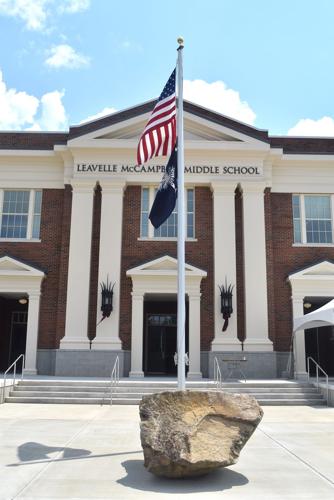GRANITEVILLE — Big, yellow buses will drop off students at the new Leavelle McCampbell Middle School in Graniteville when it opens its doors for the first time Aug. 23.
But when students arrived at its predecessor, Graniteville Academy, more than 150 years ago, many came in more primitive transportation driven not by horsepower but mule power.
Principal Michelle Padgett chronicled the history of the school Aug. 5 at a dedication ceremony for the new building, saying that early school bus, a mule-pulled wagon, had a dual mission.
Owned and operated by the Graniteville Company, the first textile mill in the Southeast, the wagon started its day bringing students who lived in nearby Vaucluse to the school, which still stands today at 103 Canal St.
“After discharging the pupils at school, the wagon was then driven back to Vaucluse for a load of cloth, which was then returned to Graniteville for processing,” said Padgett, taking some of her remarks from written accounts of the school’s history according to author and retired Aiken County Public Schools English teacher Idella Bodie. “In the late afternoon, children were picked up and returned home.”
In addition to its early transportation system, Graniteville Academy had the first known successful compulsory attendance rule in the nation, said Padgett, adding that “although informal, it worked.”
“Parents were required to keep their children younger than 12 in school, or their jobs were in jeopardy,” she said. “They were fined 5 cents per day for each child absent without cause. It is said that parents were paid a wage that took the place of their children working.”
Padgett said Graniteville Academy also was the first school in the South, and perhaps the country, to furnish free textbooks.
Leavelle McCampbell Middle School can trace its history to Graniteville Academy, which today is the home of the Megiddo Dream Station, a nonprofit that provides job training for the unemployed.
Industrialist William Gregg, founder of both Graniteville Company and Graniteville, opened the academy in 1848, just one year after the mill opened, for children of the employees who worked in his textile mills.
With its distinctive trim work that looks like snowy white icicles frozen in time hanging from its eaves, the building’s architecture reflects the Carpenter Gothic style of many of the houses in the community Gregg built for his mill workers.
Through the years, Graniteville Academy grew from six grades to 10, and the building expanded, Padgett said.
Students attended school for nine months from October to July, longer than the three- or four-month terms most schools in the 19th century followed, Padgett said.
The school day began at 8:30 a.m. and ended at 4:30 p.m. with a two-hour break for lunch.
“The long lunch period allowed students to carry hot lunches to their parents in the mill, as well as have lunch themselves,” Padgett said.
The first high school class graduated in 1899.
In 1921, the Graniteville Company built Leavelle McCampbell High School – named for a Graniteville Manufacturing board member and president – just a few short blocks from Graniteville Academy, and the school became a part of the Aiken County Public School system.
In 1922, Graniteville Academy closed, and the students marched down Canal Street to the new Leavelle McCampbell High School.
In 1954, the lower grades move to Byrd Elementary School.
In 1980, grades 9-12 became a part of the new consolidated Midland Valley High School, which combined students from Leavelle McCampbell High and Langley-Bath-Clearwater High in Bath. At that time, Leavelle McCampbell High School became Leavelle McCampbell Middle School for sixth-, seventh- and eighth-grade students.
Padgett, who along with her father, her husband and their three children, attended Leavelle McCampbell and said the Graniteville community “still shares William Gregg’s same commitment to the education of students.”
“We are here to honor our past and the rich legacy that has been given to us, and to celebrate the future of education for our students,” she said at the dedication ceremony. “The investment we make in children will pay great dividends for generations to come, and we will reap the harvest of that investment. I wonder if William Gregg would have ever dreamed that we would be standing here today.”








